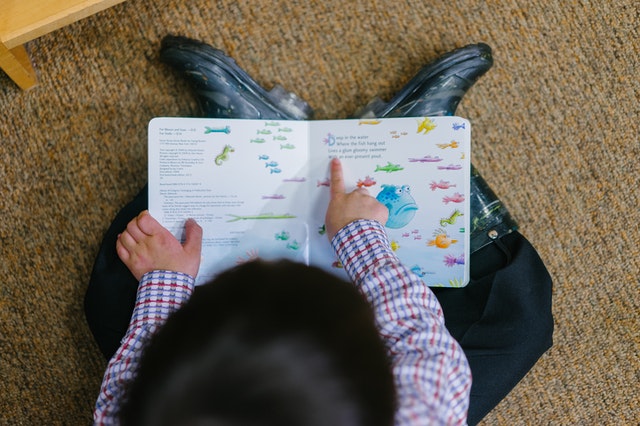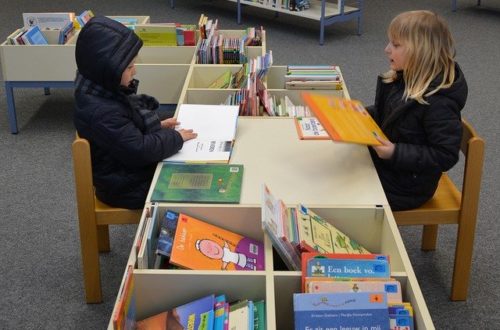As adults, we tend to take a lot of things about reading for granted.
For example, it’s obvious to us when book cover belongs in the front vs. the back. And everyone knows that English text is read from top to bottom and from left to right.
What we forget, however, is that children don’t come into the world automatically knowing these things; they have to be taught, either indirectly (from observing adults and older children read) or directly (from being taught by a caregiver or a teacher).
Even if children understand these aspects of reading well before they begin school, the actual act of turning squiggles on a page into words represents a very real challenge for many of them—no matter how enthusiastic they are about learning to read. After all, moving one’s eyes in a linear left-right sequence, line after line, page after page, for extended stretches of time, is not a natural act!
Although reading obviously involves sight, what many people don’t realize is that it actually draws on both vision and hearing. Skilled adult readers are able to absorb print at the speed of sight because their brains have essentially recorded what words look like, sound like, and mean, all as ONE piece of information.
To get to that point, however, children must learn to coordinate all those elements, and then gradually put them together more and more quickly.
That’s a lot harder than looking at pictures while being read to or watching videos on an ipad.
Sometimes, when beginning or struggling readers look at a line of text, their eyes don’t automatically move smoothly and in order over the words. They may skip words, or lines, and their eyes may even jump around the page. They may also look up before they have finished reading a sentence, and miss important information.
There is, however, one simple and fairly reliable strategy for bringing all the pieces together, and that involves using the index finger to “track” each word as it is read aloud.
Something about touching the text in sequence —actually having a kinesthetic connection to the page—focuses the eye and makes it easier for the reader to integrate all the various pieces. Essentially, it becomes impossible to not pay close attention to what one is reading; there is no way to keep one’s finger below the word being read unless one is looking directly at it.
In fact, our brains are always checking on our hand position—they are right in the middle of our field of vision, and they contain most of our touch-sensing nerves. Our tactile sensitivity is constantly relaying information to our brains.
Having one’s hands anywhere but on the book, and especially right in line with the words, will distract from reading.
Contrary to popular belief, this is not a “babyish” or “beginner” exercise. (For the record, I regularly put my finger on the words of the page/screen to help me absorb a particularly knotty bit of text, and I’ve been a professional writer for nearly a decade!)
Doing this well can be extremely challenging at first, and it may take some time to master. In fact, many of the high school students I tutored had difficulty with it. So if a child you’re working with can’t do it right away, don’t panic!
The key pieces are that the finger must always be under the word being read, and that it must move smoothly—it should not lag a word or two behind and then suddenly jump ahead, or trail off as the line progresses. Otherwise, the effectiveness of the exercise is lost.
In addition, the finger should remain on the page until the child has completely finished the relevant section—that is, it should stay firmly on the last word until the child has stopped speaking.
At first, this should also be done with a book that the child already has some familiarity with but—otherwise, there will be too many pieces to manage. The goal isn’t to decode a brand-new text but rather to have the child practice moving their eyes consistently across the page, focusing on each individual word in sequence.
It is also not a good idea to use a text that the child has completely memorized because that will eliminate much of the challenge.
You should model the reading for the child first, pointing out how your finger moves with your voice and eye. (This may seem self-explanatory to you, but it may not be at all obvious to a child.)
If the child has a lot of trouble putting all the pieces together, you may need to do the exercise with them for a little while: you and the child read the words together while you each track with a finger on a separate copy of the text.
If the child requires support after that, you can take turns reading alternate sentences.
It’s ok if things progress very slowly at first. This requires a lot of focus, and accuracy is much more important than speed: the point is simply to get all the pieces working together.
As the child becomes more comfortable reading this way and their accuracy increases, you can gradually speed things up. (Aim for no more than 2 misread/skipped words per minute before you really worry about getting faster.)
This is something you can do for just 5-10 minutes at a time, a few times a day if it isn’t too much. Once the child is able to manage the exercise well with a known text, you can move to something less familiar and see how well the child is able to transfer their skills.
Continue working until the child is able to match their finger to the text and slide it along with ease.






One Comment
Lisa
Hi Erica,
Thank you for this important post. I have found great success when teaching children to track their reading with their finger. I have also discovered that explaining the reason behind it to them is beneficial. It especially helps with “buy in” for older students who are reluctant to finger track because, as you said, they are afraid it is “babyish”. My question is, do you know of any research out there to corroborate the science of this practice. I have a parent who is resistant to her child doing this and would love some evidence to back up my claim.
Thanks again for a great post!